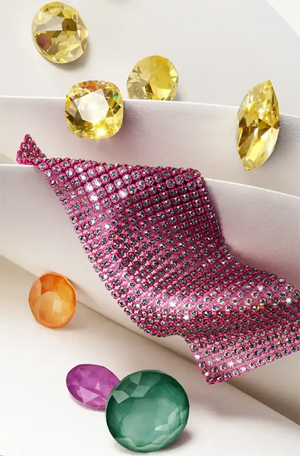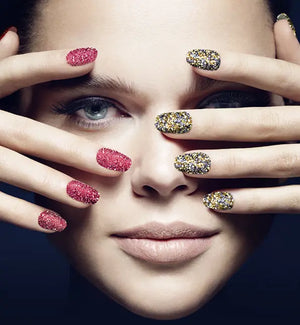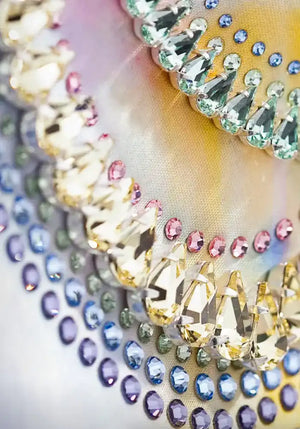
How to Choose the Best Rhinestones: 6 Tips from the Experts
Rhinestones. They look simple enough — tiny, sparkly, ready to dazzle — but choosing the right ones? That’s a whole different story. Between the endless cuts, colours, sizes, and application types, it’s dangerously easy to get overwhelmed (especially when you’re five scrolls deep into a product page and still can’t decide if “Crystal AB” or “Aurora Borealis” is more your vibe). So let’s break it down. These are our expert-backed tips on how to choose the best rhinestones — whether you're customising a dance costume, designing nail art, or about to bedazzle your entire life (in which case… yes. Do it).
Different Types of Rhinestones
First, the basics. Rhinestones come in three main materials: Glass – the standard for high-quality sparkle. Most premium brands use this. Acrylic – lightweight and budget-friendly, but they don’t sparkle quite as much. Resin – similar to acrylic, often used in crafts and beginner projects. Within those materials, you’ll also find different cuts — like faceted vs. flat back — and coatings that impact how light bounces. Want that almost holographic rainbow shimmer? You’re probably looking for something with an AB (Aurora Borealis) coating. In short: not all rhinestones are created equal. If you want maximum impact (and who doesn’t?), go glass.
Check the Quality: What to Look For
High-quality rhinestones are clear, consistent, and cut precisely. The facets should be symmetrical — no weird lopsided glints or dull patches. Here’s what we check for: Clarity: Cloudy rhinestones = cheap fillers. Cut: More facets = more sparkle. It’s maths. Kind of. Foil backing: This is what reflects the light. A strong, even foil backing gives that mirror-like shine. Consistency: If the stones in your pack are noticeably different from each other? That’s not a great sign. It’s not about being picky — it’s about getting rhinestones that perform. Especially under lights or flash photography, where cheaper ones can fall flat.
Choose the Right Rhinestone Size
This one’s easy to overlook, but size seriously matters. Flat back rhinestones are measured in SS (stone size). For example: SS5–SS10: tiny, perfect for nail art or subtle detail work SS16–SS20: medium sparkle, ideal for costumes or embellishments SS30 and up: big statement stones — great for high-impact areas If you’re mixing sizes (which we recommend, by the way — it adds depth), choose a few within a range. Think of it like layering jewellery. Everything the same size can look a bit flat. Pro tip: test a few on your actual material before committing. What looks big in the packet can look small once it’s on fabric.
Pick the Perfect Colour for Your Project
This is where it gets fun — and potentially chaotic. Clear rhinestones (like Crystal or Crystal AB) are the go-to because they reflect whatever colour is underneath. Great for versatility. But there are hundreds of colours out there. From jewel tones to pastel opals to moody metallics — all slightly different depending on the brand. So how do you pick? Match your base material if you want a subtle tone-on-tone sparkle. Go for contrast if you want the rhinestones to pop. And don’t underestimate the power of neutrals — Champagne, Jet, Silver Shade — especially when layering. Need a nudge? Take a peek at our collection and find crystals for your next design project. Sometimes, seeing them side by side is all it takes.
Decide on the Application Method
The way you apply your rhinestones can actually limit your options — so think about that before ordering. Here are your main choices: Hotfix: They’ve got heat-activated glue on the back. Use with an applicator or iron (low heat, always). Non-hotfix / flat back: No glue included. You’ll need your own adhesive — something like E6000, Gem-Tac, or nail glue depending on the surface. Self-adhesive / sticker-back: More for crafts or light-use areas. Not super durable, but very beginner-friendly. If you're working with fabric and need long-lasting hold? Hotfix is usually the way to go — especially for costumes or performance wear. For nails, it's always flat backs with strong glue.
Compare Brands and Price Points
This part’s personal. There’s no single “best” brand — but there are tiers. Premium brands (like Preciosa and Aurora) are known for their quality, clarity, and consistent sparkle. You pay more, but it shows. Mid-range brands offer good value for hobbyists or pros who don’t need stage-level impact. Budget brands can be hit or miss. Fine for practice or small crafts, but maybe don’t rely on them for your wedding dress. We always recommend testing a small quantity if you’re unsure. That way, you can see how they behave on your actual material (and whether they hold up to light, heat, glue, etc.).
Buy from Trusted Sources
Seems obvious, right? But you'd be surprised. The rhinestone market is wild. Between dodgy third-party sellers and inconsistent quality control, it’s easy to get burned. That’s why we always say: buy from shops that specialise in crystals — not just “also sell them.” A trusted retailer (like us, not to name names 👀) will:
- Offer multiple brands
- Clearly label sizes, cuts, and colours
- Let you order small packs before committing to bulk
- Actually know what they’re talking about when you ask questions
Final Thoughts
Choosing the right rhinestones shouldn’t be stressful. At least, not tear-your-hair-out stressful. But with so many variables — material, cut, colour, glue, size — it does take a bit of planning to get it right. If you’re just starting out, keep it simple: go for a neutral colour in a mid-size, try both hotfix and flat back to see what works for you, and don’t be afraid to mix brands or price points until you find what fits your project and your budget. And when in doubt? Reach out. We’re always happy to help you find crystals for your next design project.






